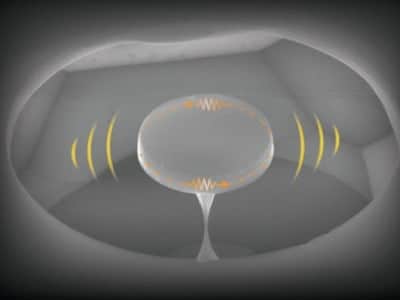
 A team of University of Calgary physicists have created a nano-sized optical resonator, which also acts as a mechanical resonator, sculpted from a single diamond crystal, an intricately crafted microdisk that has potentially revolutionary potential in the fields of quantum computing, sensors, and telecommunications.
A team of University of Calgary physicists have created a nano-sized optical resonator, which also acts as a mechanical resonator, sculpted from a single diamond crystal, an intricately crafted microdisk that has potentially revolutionary potential in the fields of quantum computing, sensors, and telecommunications.
The researchers, led by Paul Barclay and working out of the University of Calgary’s Institute for Quantum Science and Technology and the National Institute of Nanotechnology, claim that the microscopically small device has unique properties that allow it to be used in a wide variety of potential applications.
In an article published in the peer-reviewed journal Optic, called “Single-Crystal Diamond Low-Dissipation Cavity Optomechanics”, they demonstrate how this first-ever single-crystal diamond cavity optomechanical device represents an advance in the development of a hybrid quantum system, which may enable new ways for photons to control solid-state qubits by coupling mechanical resonances to both light and electron spins.
“Diamond optomechanical devices offer a platform to study the quantum behaviour of microscopic objects,” said Barclay, associate professor of physics and astronomy and Alberta Innovates Scholar in Quantum Nanotechnology in the Faculty of Science to the University of Calgary’s UToday. “These devices also have many potential applications, including state-of-the-art sensing, technology for shifting the colour of light, and quantum information and computing technologies.”
The researchers appear to have overcome the challenges associated with fabricating mechanically isolated structures from bulk diamond chips, which has previously limited the development of cavity optomechanical devices from single-crystal diamond.
While current computers, cell phones and other telecommunication devices use microcircuits that conduct electricity through wires, a future generation of computers involving quantum nanophotonics may involve transmitting information at a much smaller and more complex scale, approximately 100 times smaller than the width of a human hair.
This technology is also exciting for researchers exploring quantum physics, the study of matter and energy on a subatomic level.
“We’re excited about using these devices for devising ways to create connections for quantum computers,” said Behzad Khanaliloo, one of the paper’s lead authors and a PhD student of Barclay.
“By essentially inventing a new nano-fabrication process for single-crystal diamond, we have demonstrated a device that is pushing the state of the art in cavity optomechanics,” said Matthew Mitchell, also a PhD student and co-lead author on the paper. “It holds great promise for realizing an on-chip platform to control the interaction of light, vibrations and electrons.”
The microdisk was fabricated from commercially available synthetic, single-crystal diamond chips, using facilities at the National Institute for Nanotechnology and the University of Alberta’s nanoFAB.
“Just making the device, within the nanophotonics research community, is an accomplishment,” Barclay notes. “I would say we’re one of the best groups in the world, thanks to the work of the students, in creating optical probes to get light into and out of these devices.”
Funding for the project was provided by the National Research Council Canada, Natural Sciences and Engineering Research Council of Canada (NSERC), the National Institute for Nanotechnology (NINT), Canada Foundation for Innovation (CFI), and Alberta Innovates – Technology Futures (AITF).
Leave a Reply
You must be logged in to post a comment.




 Share
Share Tweet
Tweet Share
Share




Comment